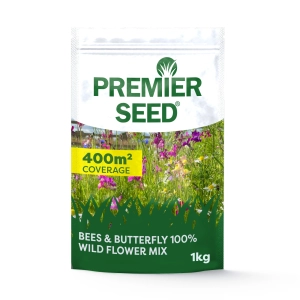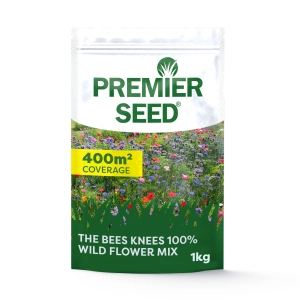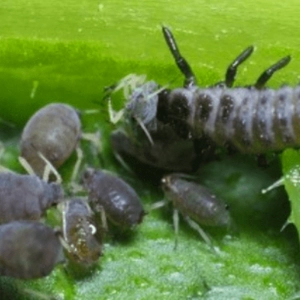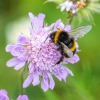
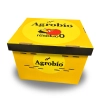
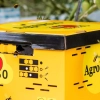
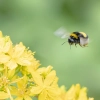

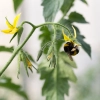
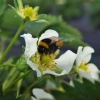




Bees for Pollination
- Two options available; indoors or outside, single hives.
- Bumble bees Bombus terrestris.
- Safe for the environment.
- Can be used to help pollinate a wide range of crops.
Full Description
Improve opportunity for pollination and natural biodiversity with our NEW live bumble bee hives. Pollinating bumblebees are ideal for vined crops like tomatoes, courgettes, peppers, and aubergine, as well as strawberries, melons and a vast range of other crops, fruiting trees and vegetables.
Placing a beehive near your crops will help improve the quality of edible produce and increase yield. The bees will work in a broad range of temperatures, from 4°C to 30°C, though their ideal flight temperature is between 10°C and 30°C.
The Power of Pollination
Pollination involves the transfer of pollen from the stamens to the pistil of a flower, a process at which bumblebees excel. Incorporating bumblebee hives into cultivation practices increases pollination success rates, resulting in better fruit set, increased fruit size and improved crop uniformity.
Pack sizes
- Single hive for indoor (greenhouse) use – one hive per 800-1000m2
- Single hive for outdoor use – one hive per 1500m2
Each hive contains:
- A fertilised queen.
- Adult workers – typically 70 to 100 bees.
- Worker pupae.
- Larvae and eggs.
- Sugar solution food.
Follow the set up and storage instructions carefully when using live bumblebees. This will ensure they are productive for the period of their natural lifecycle. Hives are available for use indoors (greenhouses), and outside. Once introduced, worker bumblebees start pollinating flowers while collecting pollen to feed the brood.
Please note, these are pollinating bees, and not honeybees. Worker bees will create a nest, so you will not be able to extract honey or wax from the hive.
How Long Will The Hive Last?
The colony will reach its maximum size after six to eight weeks depending on climate and availability of food, after which time it will begin to decline in size.
The hive is equipped with enough food to support the performance of the bees for their natural lifecycle under normal conditions. As the hive goes through its life cycle, the queen will produce different worker bees, soldiers, and finally other queens. As the colony declines, the queen will leave to try and establish a new hive elsewhere.
Delivery And Storage
Due to the fact this is a living organism and requires specialist transport, all delivery details must be correct, and someone must be in to receive the parcel. Failure to do this will likely result in the product having to be replaced at an additional cost.
Set up your hive within 18 hours of receipt. If you have to store the hive before setting up, ensure you keep it in the dark at temperatures of 15°C to 22°C and with good ventilation.
Please note that delivery can take up to 2 weeks - these are a live product that have specific transportation and storage conditions.
Getting The Best From Your Bees
Bees will work hard to help pollinate any plants in proximity to the hive. To understand just how hard they work, it’s worth knowing that your worker bees will fly up to 20mph on their way out from the hive, with a top speed of around 12mph when laden with pollen – all day! Give them the space to do their job and try not to interact with them or touch the hive once it is set up unless you are repositioning it.
Bumblebees rarely sting, but it is always best to be prepared. Although you should leave the hive alone once set up, it is wise to wear protective clothing while setting it up. This should include a beekeeper’s hat with a net veil, and a protective jacket and gloves.
If you are using hives in a greenhouse environment, be aware that in spring, the outside environment is in bloom, and this can lead to bee losses as they become attracted to these external flowers. To compensate, introduce more bees from April onwards.
Don’t use pesticides or chemicals anywhere near the hive.
Where Should I Place The Hive?
- Bumblebees orient themselves by sight. Therefore, place the bumblebee hive(s) in a highly visible location so they can easily find their way back.
- It is important that there is sufficient contrast between the hive and its surroundings so that bumblebees can distinguish the hives. Our bee boxes are yellow, so avoid placing them against a yellow background for example.
- Make sure that the entrances to the bumblebee hives are clearly visible to the bumblebees and if using more than one, place the exits in different directions to ensure that the bumblebees can find an entrance.
- If using more than one box in a greenhouse setting, spread them throughout the greenhouse – you can place up to three bumblebee hives one above the other.
- Always place bumblebee hives horizontally because of the sugar water they contain. This will prevent the sugar water from leaking.
- Protect indoor (greenhouse) bumblebee hives from condensation and rainwater to prevent damage.
- Avoid overheating the hive in the summer when glasshouse heat can be intense - the ideal flight temperature for a bumblebee is between 10°C and 30°C. If temperatures do get very high, bring the hives lower down into the crop so that as little sunlight as possible reaches the hives.
- Always place hives in the shaded side of the greenhouse. Note that bumblebees will become less active when temperatures are above 28°C.
- Never place the bumblebee hives in full sunlight when placing inside or outside, and ensure they are not near other heat sources.
Our Recommendation
Full instructions will accompany the product.
- Check for activity when opening the box. In the unlikely event your bees are inactive, please report to us. There should be no more than three dead bumblebees inside the hive.
- Place hives between crops but away from direct sunlight and moisture.
- For exposed crops, close the bumblebee hives several hours before sunset.
- Always wear protective clothing such as a beekeeper’s hat and jacket to avoid stings.
- Keep hives horizontal to prevent sugar water spillage.
- Protect indoor (card) hives from condensation and rainwater.
- For further advice or guidance contact our specialists on 01522 246491.
Technical Specification
| Product | Bees for Pollination |
|---|---|
| Brand | |
| Period Of Use | Spring, Summer |
| Active Ingredient | Bumble Bees: Bombus terrestris. |
| Pack Size Coverage | Single hive for indoor (greenhouse) use will cover 800-1000m² Single hive for outdoor use will cover 1500m² |




